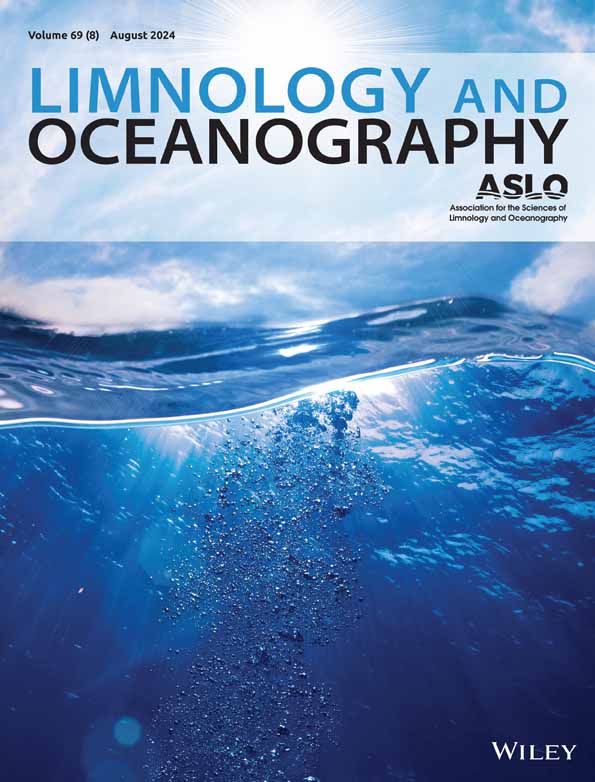从温带水域到极地水域:进入北冰洋的大西洋门户后向非蓝藻重氮化过渡
IF 3.7
1区 地球科学
Q1 LIMNOLOGY
引用次数: 0
摘要
固氮作用,即微生物将二氮还原为氨的作用,越来越被认为发生在北冰洋。然而,关于固氮生物(重氮营养体)的组成、生物地理、丰度和生态学的知识很少。这最终阻碍了在这个快速变化且主要限制氮的海洋中由固氮推动的生态系统生产力的预测。我们评估了从咸淡波罗的海河口到北冰洋海冰边缘约3400公里的地下水(8米;标记基因nifH扩增子测序和定量)中总重氮营养体和表达nifH的重氮营养体的组成和丰度。在进入大西洋通往北极的营养丰富的水域后,我们发现了从自养到异养重氮的突然转变(nifH表达)。因此,我们的研究结果表明,与邻近的温带-北方水域相比,北冰洋的重氮化在功能上是不同的,这种差异可能是由无机营养物质、盐度和温度驱动的。我们确定了北冰洋中具有北极特异性(Rhodocyclales和Oceanospirillales)或更广泛(未知的Gammaproteobacterium)分布模式的三个关键非蓝藻重氮营养菌群,并报告了它们的nifH基因转录水平(高达103个nifH转录物L−1)。相比之下,在更温暖、更缺乏营养的挪威海中,受海岸影响的海水中,nifH的表达主要由thalassa候选蓝藻杆菌亚系(UCYN‐A1, UCYN‐A2, UCYN‐A4;多达104个nifH转录本L−1)主导。随着北极大西洋化的持续推进,海洋省份和生物地理范围向极地方向移动,我们预测未来从自养向异养重氮的过渡可能会发生重大变化,固氮可能会发生重大变化。本文章由计算机程序翻译,如有差异,请以英文原文为准。
From temperate to polar waters: Transition to non‐cyanobacterial diazotrophy upon entering the Atlantic gateway of the Arctic Ocean
Nitrogen fixation, the microbial reduction of dinitrogen to ammonia, is increasingly recognized to occur in the Arctic Ocean. However, knowledge about the composition, biogeography, abundance, and ecology of nitrogen‐fixing organisms (diazotrophs) is poor. This ultimately hinders the prediction of ecosystem productivity fueled by nitrogen fixation in this rapidly changing and predominantly nitrogen‐limited ocean. We assessed the composition and abundance of total and nifH ‐expressing diazotrophs in subsurface water (8 m; amplicon sequencing and quantification of the marker gene nifH ) over ~ 3400 km from the mouth of the brackish Baltic Sea to the sea ice edge in the Arctic Ocean. Upon entering nutrient‐rich waters in the Atlantic gateway to the Arctic, we discovered an abrupt transition from autotrophic to heterotrophic diazotrophy (nifH expression). Our findings therefore suggest that diazotrophy is functionally distinct in the Arctic Ocean compared to adjacent temperate‐boreal waters—a difference likely driven by inorganic nutrients, salinity, and temperature. We identify three key non‐cyanobacterial diazotroph groups in the Arctic Ocean with Arctic‐specific (Rhodocyclales and Oceanospirillales) or more widespread (unknown Gammaproteobacterium) distribution patterns and report their nifH gene transcription levels (up to 103 nifH transcripts L−1 ). In contrast, nifH expression in the warmer and more nutrient‐poor Norwegian Sea with coastal‐influenced water was dominated by sublineages of Candidatus Atelocyanobacterium thalassa (UCYN‐A1, UCYN‐A2, UCYN‐A4; up to 104 nifH transcripts L−1 ). With ongoing atlantification of the Arctic pushing oceanic provinces and biogeographical ranges poleward, we predict a future displacement of the transition from autotrophic to heterotrophic diazotrophy with likely significant changes in nitrogen fixation.
求助全文
通过发布文献求助,成功后即可免费获取论文全文。
去求助
来源期刊

Limnology and Oceanography
地学-海洋学
CiteScore
8.80
自引率
6.70%
发文量
254
审稿时长
3 months
期刊介绍:
Limnology and Oceanography (L&O; print ISSN 0024-3590, online ISSN 1939-5590) publishes original articles, including scholarly reviews, about all aspects of limnology and oceanography. The journal''s unifying theme is the understanding of aquatic systems. Submissions are judged on the originality of their data, interpretations, and ideas, and on the degree to which they can be generalized beyond the particular aquatic system examined. Laboratory and modeling studies must demonstrate relevance to field environments; typically this means that they are bolstered by substantial "real-world" data. Few purely theoretical or purely empirical papers are accepted for review.
 求助内容:
求助内容: 应助结果提醒方式:
应助结果提醒方式:


